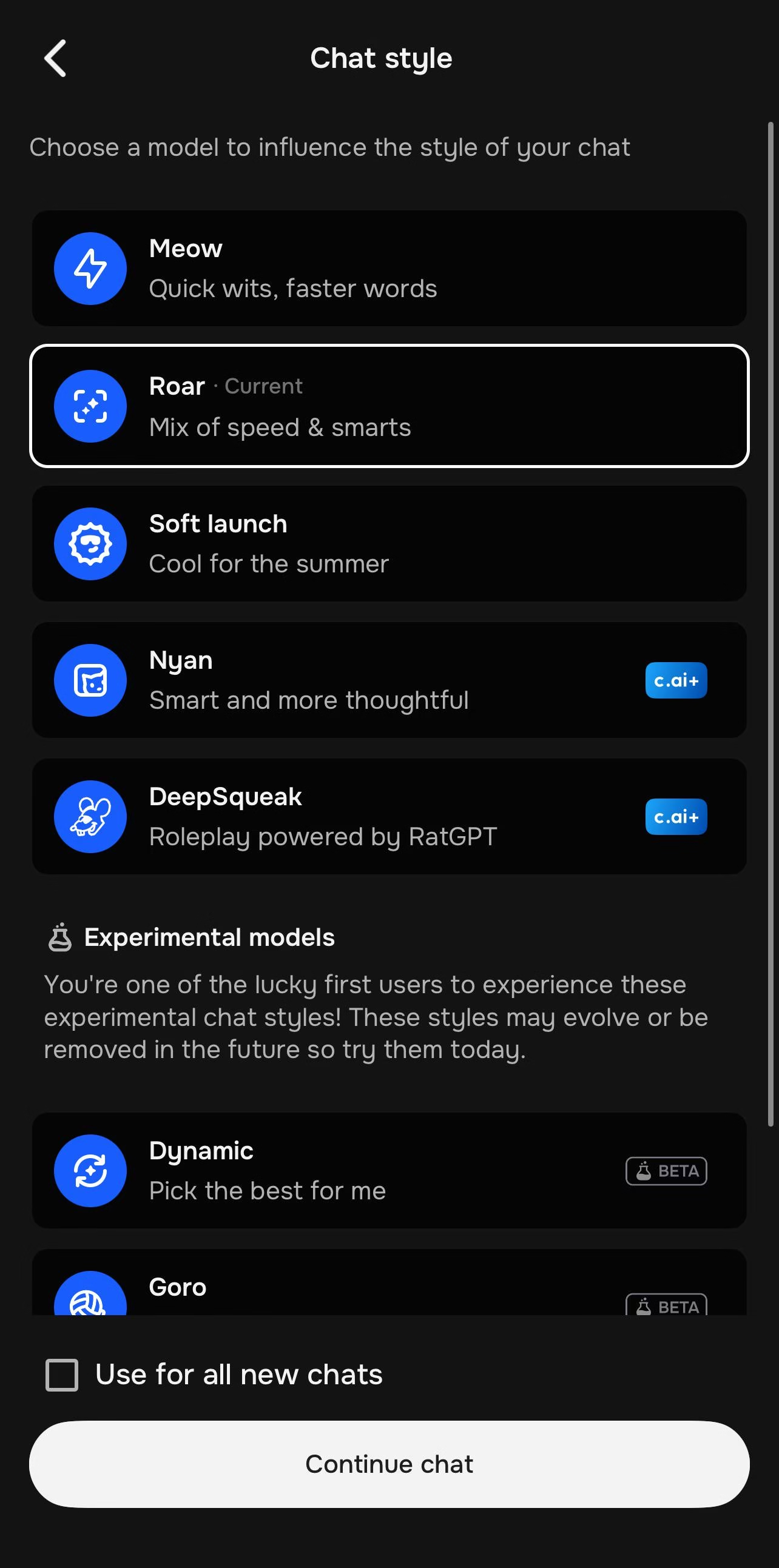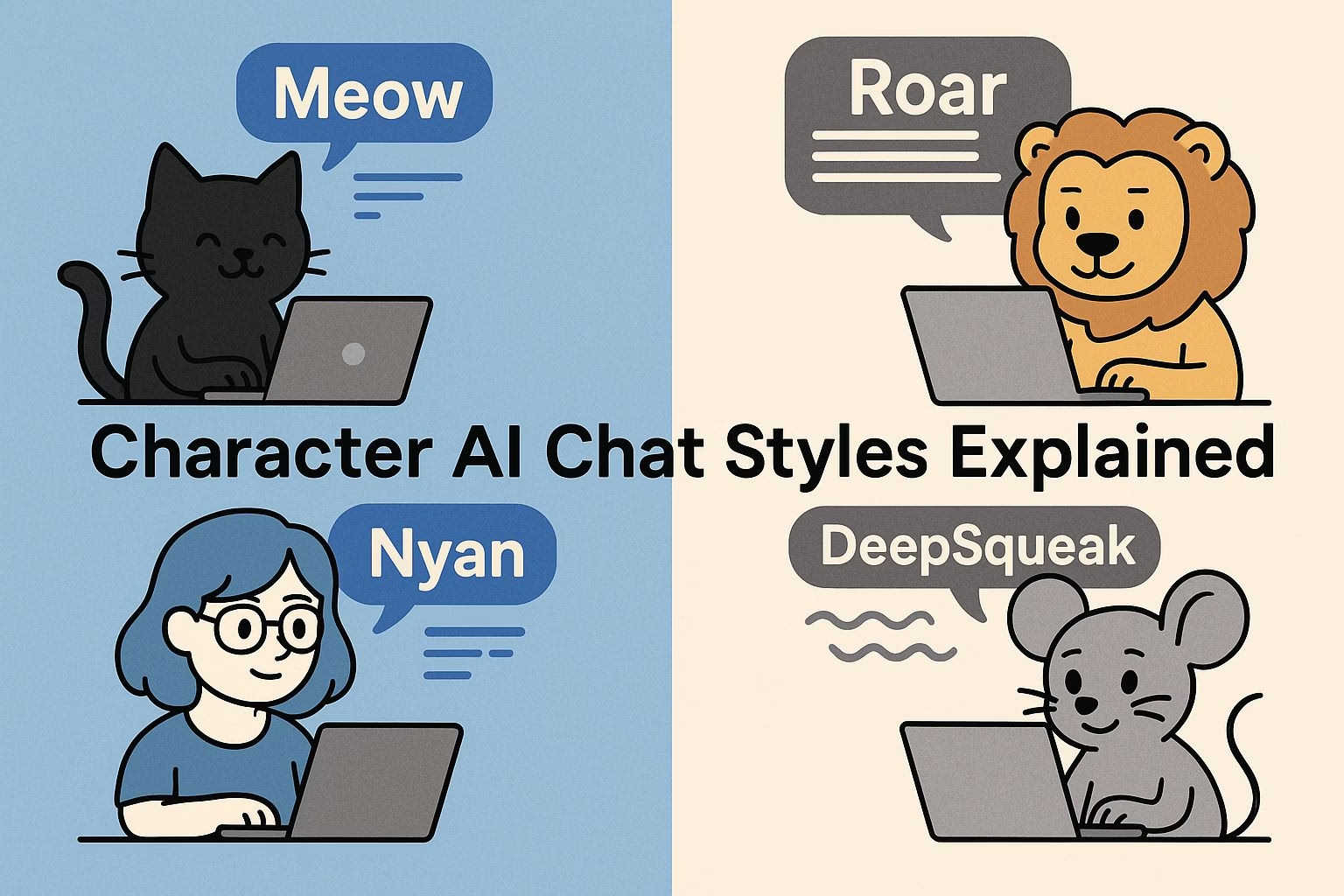Breaking Down Character AI Chat Styles and What They Really Mean
Character AI recently introduced a list of chat styles with names like Meow, Roar, Soft Launch, and DeepSqueak.
The problem is that the app itself gives little explanation beyond vague taglines such as “quick wits, faster words” or “cool for the summer.”
For many users, these descriptions create more confusion than clarity.
That’s why discussions on Reddit have become the main source of real information. Users compare notes, share frustrations, and point out hidden differences that aren’t obvious at first glance.
Some styles like Roar are praised for smarter, longer replies, while others like Meow feel rushed and shallow.
DeepSqueak is popular among roleplayers, but people also complain it breaks often.
Then there are options like Soft Launch and Goro, which have left many unsure of their purpose.
If you’re trying to figure out which style works best for your chats, it helps to understand what each one actually does.
In this article, I’ll break down the main chat styles, summarize what the community has said about them, and give you practical examples of where each shines and where it falls short.
Styles focused on speed and balance
The first two options most people notice are Meow and Roar.
They are often compared directly because both focus on response speed, but they differ in how much “thinking time” the AI takes before replying.
If you want faster conversations, these are usually the ones you’ll test first.
Meow
Meow is designed for speed. Users often describe it as giving “faster replies with less thinking.” That makes it a good option if you want quick back-and-forth conversation without waiting long for a response.
The tradeoff is that answers can feel shallow or rushed. Some people find that Meow trips over itself, producing repetitive or unfinished lines when it tries to keep up the pace.
Example: If you’re roleplaying and type, “Tell me about the castle we’re entering,” Meow might respond instantly with a short, simple description.
It works well if you value speed over depth, but it won’t deliver the same richness you’d get from other styles.
Roar
Roar takes a step further by balancing speed with more thoughtful replies. Many users say it produces smarter, longer responses that can sometimes fill an entire screen.
Others compare it to Meow but with an extra layer of detail. That makes it popular for roleplayers who want a mix of quick interaction and stronger immersion.
Community reactions to Roar are mixed. Some praise it for being “heavenly,” while others complain about repetitive, copy-paste-like lines.
A few have even noticed shifts over time, with Roar at first offering rich replies and later slipping back into shorter, formulaic messages.
Example: In the same castle scenario, Roar might give you a descriptive passage about the castle’s architecture and atmosphere. It slows down slightly compared to Meow, but the result feels more alive and detailed.
Styles that aim for depth and flexibility
After trying the faster options, many users look for chat styles that offer more substance.
Soft Launch and Nyan are often mentioned in this category because they focus less on speed and more on depth.
Both styles can deliver richer replies, but they come with their own quirks and reliability issues.
Soft Launch
Soft Launch is often described as a less filtered, more adult-friendly style. Users say it allows for spicier or more daring responses compared to Roar or Meow.
It’s popular with people who feel that Character AI can sometimes be too restrictive, especially when it comes to creative or mature roleplay.
The main drawback is consistency. Some users praise Soft Launch as “pretty good” when it works properly, but others say it feels buggy or incomplete.
A few have even noticed that it’s better at handling chaotic, internet-style conversations where you throw random characters or scenarios into the mix.
This makes it appealing if your chats are unpredictable, but frustrating if you want stability.
Example: If you ask Soft Launch to continue a roleplay with unpredictable twists, say, suddenly introducing a new villain or shifting the setting to another world, it will usually go along with it more easily than Roar or Meow.
The problem is that it may also lose track of details or break character when pushed too far.
Nyan
Nyan is widely seen as the “smarter” option among the available styles. Users describe it as producing more thoughtful and often better-quality replies.
It takes longer to respond compared to Meow or Roar, but the tradeoff is that its answers feel more deliberate and less rushed.
The downside is reliability. People report that Nyan sometimes breaks, either cutting replies short or failing to respond as expected.
Still, when it works, it’s often praised as the closest to a truly intelligent conversational partner among the styles.
Example: In a roleplay where you ask for detailed world-building, Nyan might give you layered descriptions of the culture, politics, and setting.
While this can take longer, it feels like the AI has “thought” about the answer, making the interaction more immersive.
Styles tailored for roleplay and adaptability
Some chat styles are designed with roleplay in mind or with the ability to adapt to your conversation.
DeepSqueak and Dynamic fall into this group, each with strengths that appeal to different types of users.
DeepSqueak
DeepSqueak is tuned specifically for roleplay. Many users call it the best option for immersive storytelling because it generates long, detailed, and character-driven replies.
It focuses heavily on maintaining the roleplay experience, which makes it popular among those who want conversations that feel like collaborative storytelling rather than quick chats.
The catch is stability. DeepSqueak has a reputation for breaking often, going out of character, or apologizing mid-conversation in ways that disrupt immersion.
This frustrates users who love its depth but can’t rely on it for consistent quality.
Example: In a roleplay where you’re exploring a haunted forest, DeepSqueak might deliver atmospheric paragraphs filled with sensory details and tension. But at random points, it could stop and insert an out-of-place “Sorry, I didn’t mean to…” which breaks the flow.
Dynamic
Dynamic is designed to adjust automatically based on your conversation. Instead of sticking to one preset style, it changes tone and approach depending on the direction of the roleplay.
For example, if you shift from lighthearted banter to serious storytelling, Dynamic may respond in kind.
This flexibility makes it attractive to users who don’t want to pick a single style, but it can also feel inconsistent.
Some praise it as their go-to, saying it “blends them all into one,” while others find it unpredictable. Since it tries to adapt, your experience can vary widely depending on how you steer the chat.
Example: If you start with playful dialogue and then move into a dramatic battle scene, Dynamic might switch from short, witty lines to more elaborate and serious descriptions without you needing to change styles manually.
Styles with specific restrictions and strengths
Not all chat styles are aimed at speed or roleplay. Some are meant to narrow the tone or improve technical aspects like language handling.
Goro and Pawly are two such examples, but they serve very different purposes.
Goro
Goro is often described as less spicy and more restrained. Many users think of it as the “family-friendly” style, where responses lean toward being robotic and safe.
Some even call it soulless, noting that it avoids risky or creative paths and instead sticks to very straightforward replies.
Interestingly, a few users have reported the opposite, saying Goro unexpectedly produced “spicy” or detailed content.
This inconsistency may come from the style still being in beta, meaning it doesn’t always behave as intended. Because of this, Goro has mixed reception.
For those who prefer toned-down, neutral conversations, it can work well. But if you’re after emotional or imaginative roleplay, Goro may feel flat.
Example: If you ask Goro to describe a dramatic duel, it might respond with a clean, simple summary of events instead of the rich details you’d get from DeepSqueak. On the other hand, a few users say it sometimes does the opposite, showing that it’s not entirely predictable.
Pawly
Pawly stands out for being better with languages. Users mention fewer errors in grammar and translations, which makes it useful if you’re chatting in something other than English.
It also produces smoother roleplay compared to Roar, though the difference can sometimes be subtle.
This makes Pawly appealing for bilingual users or anyone who wants fewer mistakes in multi-language roleplay. It may not be the most creative or immersive option, but it does improve technical accuracy.
Example: If you switch mid-chat from English to Spanish, Pawly is more likely to keep up without awkward phrasing or broken grammar.
For roleplayers who mix languages into their stories, this reliability can be a big advantage.
A lighter version of DeepSqueak
Pipsqueak
The last style worth noting is Pipsqueak, which was briefly available before being removed. Users described it as a smaller or more lightweight version of DeepSqueak.
It offered much of the same immersive roleplay strength but in a less heavy format that didn’t break as often.
Many praised it as “absolutely amazing” during the time it was available, with some even preferring it over DeepSqueak for long roleplay sessions.
Unfortunately, Pipsqueak has been taken away for now, leaving those who enjoyed it disappointed.
Based on community feedback, it may return in the future, and if it does, it’s expected to become a favorite again for people who want a balance between DeepSqueak’s depth and more reliable stability.
Example: In a roleplay where you ask for a description of a tense negotiation between rival kingdoms, Pipsqueak could give layered dialogue and political tension without the frequent breaks that frustrate DeepSqueak users.
Comparison of Character AI Chat Styles
| Chat Style | Strengths | Weaknesses | Best For |
|---|---|---|---|
| Meow | Fast replies, good for quick chats | Shallow or rushed answers, repetitive | Fast back-and-forth chatting |
| Roar | Balanced speed and detail, longer responses | Inconsistent, sometimes formulaic | Balanced roleplay and casual chats |
| Soft Launch | Less filtered, allows more creative or mature replies | Buggy, unreliable, loses track | Unfiltered, chaotic conversations |
| Nyan | Smarter, more thoughtful replies | Breaks sometimes, slower replies | Immersive and intelligent roleplay |
| DeepSqueak | Detailed roleplay, immersive storytelling | Breaks often, goes out of character | Rich, atmospheric roleplay |
| Dynamic | Adapts to conversation style automatically | Inconsistent quality, unpredictable | Flexible, shifting roleplay styles |
| Goro | Restrained, safe, family-friendly tone | Flat, robotic, sometimes soulless | Safe and neutral conversations |
| Pawly | Better at languages, fewer errors | Less creative, subtle improvements only | Bilingual or language-heavy roleplay |
| Pipsqueak | Compact version of DeepSqueak, strong roleplay | Removed for now, availability limited | Lightweight roleplay option |
Choosing the right chat style
With so many chat styles available, it’s easy to feel overwhelmed. The key is to focus on what you value most in your interactions.
If speed matters, Meow and Roar are the natural choices. If you want depth, Nyan and DeepSqueak are stronger, though they come with stability issues.
For adaptability, Dynamic is worth trying. If you prefer safe and neutral conversations, Goro fits that role, while Pawly is the clear pick for multilingual or language-heavy chats.
The biggest challenge is that Character AI has not provided clear documentation. Users rely on trial, error, and community posts to figure out how these styles actually work.
Until proper descriptions are added in the app, the best approach is to experiment and decide which style matches your needs.


